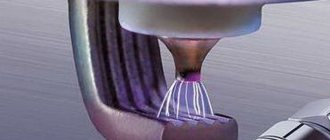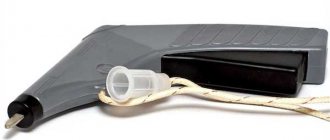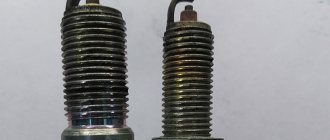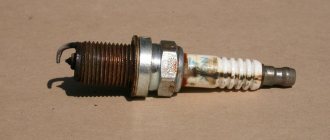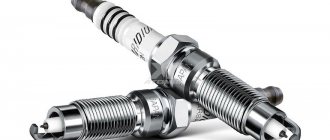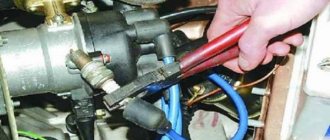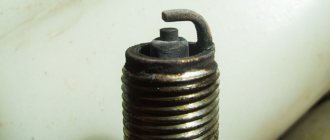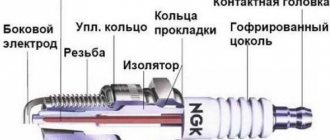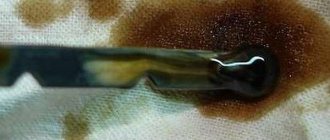What should you be wary of?
In order to change spark plugs in a timely manner, thereby minimizing all sorts of troubles, you need to know the main signs of bad spark plugs. A car owner should be wary if:
- it is difficult to start the engine - the starter is activated, but the engine does not start or starts after several starts of the starter;
- the engine begins to “trouble” - “twitches” while driving (this is especially pronounced at idle), power/traction decreases;
- fuel consumption increases;
- the CO level in the exhaust increases;
- The engine dynamics have deteriorated (it picks up speed poorly, which means the power drops).
the wear of the spark plugs (SZ) by visual inspection. To do this, you need to extract and see what the SZ looks like. During normal operation of the power unit, carbon deposits on the SZ have a light gray-brown color. If you find one of the following deviations from the norm, the spark plugs need to be replaced.
Signs of replacing spark plugs and the reasons for their appearance:
- The spark plug body has mechanical damage, the electrodes or sealing washers have a changed shape. The presence of these symptoms indicates the need to replace the SZ. The reasons may be as follows:
- discrepancy between the heat index of the SZ and the type of motor;
- the cooling system is malfunctioning;
- high ignition timing.
- Black carbon deposits are a sign of excessively enriched fuel, which, when burned incompletely, forms excess soot, or the ignition spark does not have sufficient strength.
- The SZ acquired a shiny glassy appearance. This symptom is a sign of overheating of the spark plugs, which occurs when a lean fuel mixture is used or the car is operated on a gas-air mixture.
- The formation of oily deposits indicates the presence of motor fluid inside the combustion chamber due to the leakage of lubricants through the oil-removable valve caps of the cylinder head, or the piston system is worn out.
- On the SZ there is brown-yellow scale, formed due to soot on the dielectric of the tip of the spark plug.
- A chip/break of SZ insulators indicates sudden overheating/cooling.
- The occurrence of erosion on spark plug contacts is due to the presence of lead oxidative reactions. The reason is an increased spark plug gap.
- The melted SZ contact is a consequence of overheating.
- Scale of a reddish hue is a clear sign of excess metal-containing additives in the fuel mixture.
A common mistake when inspecting SZ
The SZ study is carried out after a long period of operation of the power unit. A misconception among motorists is that during a cold start of the power unit at temperatures below zero and instability in engine operation, the spark plugs are unscrewed. Seeing black soot on the NW, a hasty conclusion is made. However, this can happen when operating the engine during a cold start; at this moment, the mixture becomes richer under duress, and instability of operation is caused, for example, by unsatisfactory electrical conditions (pay attention to high-voltage wires, etc.).
Therefore, remember - if, in your opinion, the operation of the power unit of your car is unsatisfactory, then you should not diagnose its operation based on external signs of SZ. You need to drive at least 300 km on new spark plugs and only then can you draw any conclusions.
Faulty spark plugs almost always lead to various kinds of problems in the operation of the car engine. For example, unstable idling (the engine “troits”, the speed fluctuates), dips, jerking, twitching, loss of power and throttle response, difficult starting (both cold and hot) are often a consequence of the use of defective spark plugs.
First of all, we check for the presence of a spark at the electrodes of the spark plugs. Then you need to unscrew them from the engine and carefully inspect them. At the same time, this procedure will be a diagnostic of the operation of your car’s engine, since their appearance is an indicator of what is happening inside it.
Below is a list of the main, ubiquitous spark plug faults.
Cracks on the insulator
Visually visible cracks and chips on the spark plug insulator are a reason to immediately replace it. They can appear either on the top of the spark plug insulator or on the heat cone around the central electrode. The reasons for their appearance are natural wear and tear as a result of long-term use, poor quality of the insulator material, non-compliance with the technology of its manufacture (for example, with a noticeable longitudinal seam from the connection of its two halves), detonation as a result of an incorrectly set ignition timing, low-quality fuel or mismatch in heat rating required for a given engine.
Possible reasons for the appearance of soot
Before answering the question of why the candles are black, you need to decide how exactly they turned black . After all, it depends on which direction to search. In particular, the candles can turn black all together, or maybe only one or two of the set. Also, the candle may turn black only on one side, or perhaps along its entire diameter. There are also so-called “wet” and “dry” carbon deposits.
It should be noted that the speed of appearance and nature of carbon deposits directly depends on existing faults (if any):
- Carbon deposits on new spark plugs begin to form after at least 200-300 km. Moreover, it is advisable to drive along the highway at approximately the same speed and engine load. This way the spark plugs will work in optimal mode, and it will be possible to more objectively assess the condition of the car’s components.
- The amount and type of soot depends on the quality of the fuel used. Therefore, try to refuel at trusted gas stations, and not drive with gasoline or similar mixtures. Otherwise, it will be difficult to establish the real cause of the appearance of soot (if it occurs).
- In a carburetor engine, the idle speed must be set correctly.
Now let's move directly to the question of why black soot appears on the spark plugs. There may be 11 main reasons :
- If you notice blackening on only one side, then most likely this is caused by a burnt-out valve. That is, carbon deposits on the spark plug fall on the side electrode from below (and not on the central one).
- The cause of black spark plugs may be a burnt-out valve. The situation is similar to the previous one. Carbon deposits may penetrate the bottom electrode.
- An incorrectly selected glow rating of a spark plug causes not only damage to it during further use, but also uneven blackening at first. If the mentioned number is small, then the shape of the soot cone will change. If it is large, then only the top of the cone will turn black, and the body will be white.
“Dry” carbon deposits on a candle
As a rule, when the ignition is set late and the air-fuel mixture is rich, the following consequences arise:
- misfires (error P0300 appears on injection engines);
- problems starting the engine;
- unstable engine operation, especially at idle, and as a result, increased vibration levels.
Next, we will tell you how to eliminate the listed faults and how to clean the spark plugs.
You can't drop candles
A candle is a fragile product that requires careful handling. It should not be dropped, which may damage the ceramic insulator or side electrode. When the gap between the electrodes changes, interruptions in engine operation and, in worst cases, even misfires begin. The spark that is formed under such conditions is not always enough to ignite the fuel mixture. Unburnt fuel, along with exhaust gases, is released into the exhaust system and enters the catalytic converter, where it is burned. As a result, the temperature rises and the cells of the technical unit are damaged.
A broken insulator can lead to other problems. When heated, the crack expands and can split the ceramic into several parts, which risk falling off and getting into the gap between the cylinder wall and the piston. In this case, scuffing appears and the engine will require expensive repairs. You will have to remove the attachments and dismantle the cylinder head.
Question answer
In what cases can you not warm up the engine for a long time?
What to do if soot appears
First of all, it is necessary to remember that oil contamination and overheating, which results in soot on the spark plugs, are very harmful to the ignition system . Overheating is especially dangerous, since it causes the possibility of failure of the electrodes on the spark plugs without the possibility of their restoration.
If your car only has one blackened spark plug, you can diagnose the breakdown by simply swapping the spark plugs. If after this the new spark plug also turns black and the old one clears up, it means that the problem is not in the spark plugs, but in the cylinder. And if nothing has changed, then questions arise about the performance of the candle itself.
Cleaning spark plugs from deposits
Cleaning candles must be done regularly, as well as inspecting their condition. It is recommended to do this after approximately 8.10 thousand kilometers . It is very convenient to do this when changing the engine oil. However, if the symptoms described above occur, you can do this earlier.
it is not recommended to use the old method of using sandpaper to clean electrodes . The fact is that this creates a risk of damaging the protective layer on them. This is especially true for iridium spark plugs . Their central electrode is thin and coated with iridium, which is a semi-precious and rare metal.
To clean spark plugs you will need:
- detergent to remove plaque and rust;
- disposable plastic cups (after completion of the cleaning procedure they must be disposed of; they cannot be used for food products in the future);
- a thin brush with hard bristles or a toothbrush;
- rags.
The cleaning procedure is performed according to the following algorithm:
- The cleaning agent is poured into a glass prepared in advance to a level that completely immerses the spark plug electrodes (without an insulator).
- Immerse the candles in the glass and leave for 30-40 minutes (during the process, a chemical cleaning reaction occurs, which can be observed with the naked eye).
- After the specified time has elapsed, the candles are taken out of the glass, and using a brush or toothbrush, plaque is removed from the surface of the candle, especially paying attention to the electrodes.
- Wash the candles in warm running water, removing the chemical composition and dirt from their surface.
- After washing, wipe the candles dry with a rag prepared in advance.
- The final stage is to dry the candles on a radiator, in the oven (at a low temperature of +60...+70°C) or using a hairdryer or fan heater (the main thing is that the remaining water in them completely evaporates).
The procedure must be carried out carefully, cleaning and removing all dirt and plaque present on the surface. Remember that washed and cleaned candles are 10.15% more effective than dirty ones .
Results
The appearance of a black spark plug on a carburetor or injector can be caused by various reasons. As a rule, there are several of them at once . For example, incorrectly selected spark plugs, prolonged engine operation at high speeds, incorrectly set ignition, faulty valve stem seals, and so on. Therefore, we recommend that if the symptoms described above appear, you simply periodically check the condition of the spark plugs on your car.
This way you will not only extend the life of the engine, but also maintain power and driving comfort. You can see additional information on how you can diagnose a car engine by the color of spark plug soot.
What to do when the candles are flooded
Solve the problem with candles. Change the kit to a new one, carry out complete or partial cleaning. Partially: wipe the candle with a dry rag, burn it on an open flame (gas burner, etc.). Completely: use a soft metal wire to clean dirt from the spark plug glass (between the electrode insulator and the body). The contacts are cleaned with “zero” sandpaper folded in two. Check the gap with a calibration probe. They burn through.
The engine is purged by driving it with the starter with the spark plugs removed to remove excess or contaminated mixture.
